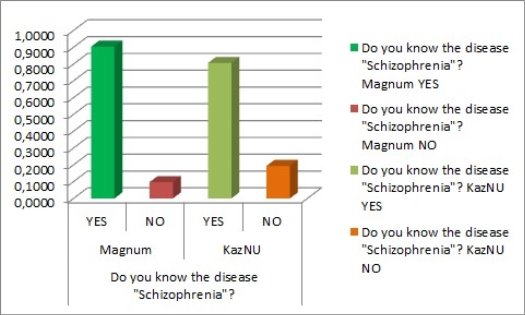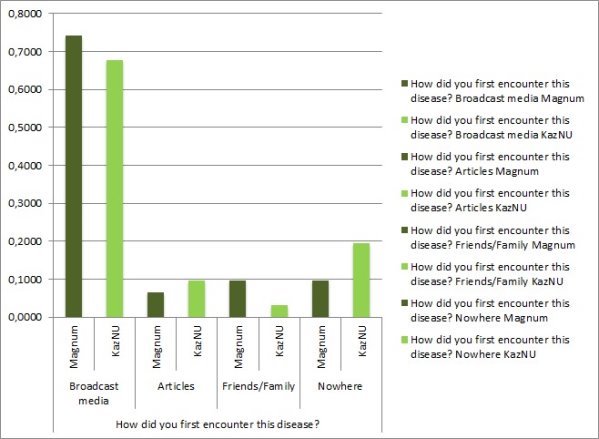In everyday life, people have prejudices that schizophrenics commit crimes. Media almost always depicts mentally ill people as perpetrators, and thus their crimes tend to become big headline-making acts that stuck in people’s heads. Hence, such judgmental attitude of public may negatively affect lives of these mentally ill people. Our team wants to investigate this issue because we believe that the vast majority of people with mental illnesses, in our case schizophrenics, are not violent and dangerous. We want to challenge this topic to raise awareness of faulty representation of schizophrenics in crime. Thus, we conducted a statistical analysis to demonstrate the importance of this social problem.
Schizophrenia is a form of chronic psychosis, which may be very disabling and lead to variety of negative consequences for the individuals affected by the disorder such as disorganized behavior, paranoia, hallucinations and etc. (Kredentser, 2014).
Over a third of the public assume that people with a mental health problem are likely to be violent — in fact people with severe mental illnesses are more likely to be victims, rather than perpetrators, of violent crime. The follow-up studies showed that there is no association between schizophrenia and crime. According to these studies individuals with schizophrenia tend to commit less crime as compared to non-disorder individuals. Research conducted by American Psychological Association indicated that among a total of 429 committed criminal acts only 4 percent of the offences were directly linked to schizophrenia. Consequently, patients with schizophrenia have no tendency to kill someone.
Nevertheless, due to the impact of mass media in everyday life, people still hold misconceptions about the involvement of schizophrenics in crime. Broadcast media in particular emphasises schizophrenics’ adherence to violence and crime, which can be seen in movies such as “Nightmare on Elm Street”, “Friday the 13th”, “The Shining”. This research paper explores to what extent ordinary people consider schizophrenics as perpetrators and dangerous as well as it tackles the questions of media’s influence on schizophrenics’ representation in crime.
The primary aim of our research is to reduce public fear of mentally disordered people and raise awareness on the mythical relationship between schizophrenia and criminal offending. Another aim of the research is to find whether there is a difference between opinions regarding the issue in two different generations.
Methodology



Our null hypothesis is that people do not consider schizophrenics as criminals. Our alternative hypothesis is that people do consider schizophrenics as criminals. Samples that were analysed in this research were obtained by systematic random sampling. This method was used because systematic random sampling is the most efficient way to randomly collect sample subjects without any time difficulties, such as putting names of subjects in bag or numerating all people in an organization and after that using the random number generator. We assumed that the number of people in Magnum is approximately equal to 310, and then we used the random number table to determine the starting point of our sample, that is, the subject that would be chosen first. After that we interviewed every 10th subject, so that overall we got 31 random subjects of our sample. The same method was used to obtain the second sample from KazNU.
Our team conducted a hypothesis test for the difference between proportions in order to investigate whether there are differences in opinions of two different generations from KazNU and Magnum. Since the difference between the two proportions was found to be not significant, we decided to randomly pick one sample to explore the findings of the second question that essentially related to the main aim — to see whether people believe in the direct relationship between schizophrenia and crime. By flipping a coin we randomly chose the sample from KazNU and examined its results. Using one sample z-test for proportion we investigated the significance of the answers regarding whether media was the main source of finding out about the disease.
Our structured, standardised interview consisted of 6 close-ended questions and 1 likert scale question. They are:
1. Do you know the disease «Schizophrenia»? (YES/NO)
2. Do you think there are a large number of schizophrenics involved in crime? (YES/NO)
3. Would you want to issue a law forbidding schizophrenics to roam the streets? (YES/NO)
4. Do you think we need to change our opinion about schizophrenics and people with mental illnesses? (YES/NO)
5. Do you think Kazakhstani people's attitude to such people harm their daily life? (YES/NO)
6. Assess the danger of schizophrenics to surrounding people from 1 to 5. (5 being really dangerous)
7. How did you first encounter this disease? (Broadcast media/ Articles/ Friends and Family/ Nowhere)
Results
The difference between proportions of people from Magnum and KazNU students who consider schizophrenics as criminals is not significant at 5 % significance level, which means that they may be equal to each other or they may not. At 5 % significance level there is strong evidence that the majority of KazNU students consider schizophrenics as criminals. In addition, there is strong evidence that the majority of people from both Magnum and KazNU found out schizophrenics through media.
Conclusion
One of the null hypotheses of the research, which stated that the majority of Kazakhstani people do not consider schizophrenics as criminals, was proven false by the statistical analysis of the two representative samples. This statistical analysis lead us to the result that perspectives of the two different generations may not differ greatly from each other. Additionally, our research revealed that general public is indeed vulnerable to judgmental interpretations regarding schizophrenics’ involvement in crime due to the influence of media.
Ultimately, our team also encountered several potential biases and errors. In particular, biases such as response, nonresponse and undercoverage were taken into account. Instances of response bias in our research include demand characteristics and social desirability. The respondents could have lied about their true knowledge of the topic in order to either help us support our alternative hypotheses or to present themselves as being politically correct. Nonresponse bias was observed when the potential participants refused to participate in the interview, while the research may have also entailed undercoverage bias due to a number of social groups not being represented in Magnum and KazNU at the time of the research.
References:
1. Abdey J. S., Subject Guide Statistics 1, 2014
2. Mental Illness Not Usually Linked to Crime, Research Finds. (2014, April 21). Retrieved from http://www.apa.org/news/press/releases/2014/04/mental-illness-crime.aspx
3. Smith, Brian. «Mental Illness Stigma in the Media». e Review: A Journal of Undergraduate Student Research 16 (2015): 50–63.
4. Suzdaltsev, J. (2014, October 22). We Spoke to a Psychologist About Hollywood's Depictions of Mental Illness. Retrieved from https://www.vice.com/sv/article/xd5mgn/hollywood-sucks-at-portraying-mental-illness

